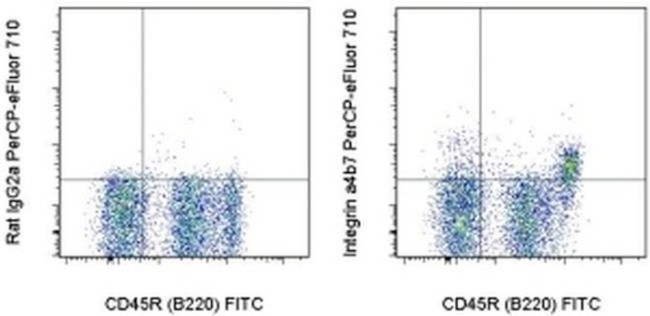Search Thermo Fisher Scientific
Invitrogen
Integrin alpha 4 beta 7 (LPAM-1) Monoclonal Antibody (DATK32 (DATK-32)), PerCP-eFluor™ 710, eBioscience™
FIGURE: 1 / 1
Integrin alpha 4 beta 7 (LPAM-1) Antibody (46-5887-82) in Flow

Product Details
46-5887-82
Species Reactivity
Published species
Host/Isotype
Recommended Isotype Control
Class
Type
Clone
Conjugate
Excitation/Emission Max
Form
Concentration
Purification
Storage buffer
Contains
Storage conditions
Shipping conditions
RRID
Product Specific Information
Description: The DATK32 monoclonal antibody binds to a combinatorial epitope of mouse LPAM-1 (alpha 4/ beta 7), which is a heterodimer of the the 154 kDa alpha 4 subunit and the 130 kDa beta 7 subunit. In mouse, the beta 7 subunit is found on the majority of mature lymphocytes and a small population of thymocytes and bone marrow cells. LPAM-1 is an integrin involved in the transendothelial migration of lymphocytes across high endothelial venules (HEV), and is know to bind several ligands including MAdCAM-1, VCAM-1 and fibronectin. Binding of the DATK32 monoclonal antibody has been shown to induce aggregation of the CD8+ T cell lymphoma TK1, and block LPAM-1-mediated cell adhesion.
Applications Reported: This DATK32 (DATK-32) antibody has been reported for use in flow cytometric analysis.
Applications Tested: This DATK32 (DATK-32) antibody has been tested by flow cytometric analysis of mouse bone marrow cells. This can be used at less than or equal to 0.5 µg per test. A test is defined as the amount (µg) of antibody that will stain a cell sample in a final volume of 100 µL. Cell number should be determined empirically but can range from 10^5 to 10^8 cells/test. It is recommended that the antibody be carefully titrated for optimal performance in the assay of interest.
PerCP-eFluor® 710 emits at 710 nm and is excited with the blue laser (488 nm); it can be used in place of PerCP-Cyanine5.5. We recommend using a 710/50 bandpass filter, however, the 695/40 bandpass filter is an acceptable alternative. Please make sure that your instrument is capable of detecting this fluorochrome.
Fixation: Samples can be stored in IC Fixation Buffer (Product # 00-822-49) (100 µL cell sample + 100 µL IC Fixation Buffer) or 1-step Fix/Lyse Solution (Product # 00-5333-54) for up to 3 days in the dark at 4°C with minimal impact on brightness and FRET efficiency/compensation. Some generalizations regarding fluorophore performance after fixation can be made, but clone specific performance should be determined empirically.
Excitation: 488 nm; Emission: 710 nm; Laser: Blue Laser.
Filtration: 0.2 µm post-manufacturing filtered.
Target Information
Integrin beta 7 associates with integrin alpha 4 (CD49d) to form the alpha 4 beta 7 integrin LPAM-1, expressed on intraepithelial lymphocytes. It also associates with alpha E (CD103) to form the alpha E beta 7 integrin HML-1, expressed on T cells adjacent to mucosal epithelium and intraepithelial lymphocytes. Ligands for LPAM-1 include VCAM-1 (CD106), MAdCAM-1 and fibronectin, while the ligand of HML-1 is E-cadherin (CD324). Integrin beta 7 plays an important role in the adhesion of leukocytes to endothelial cells promoting the transmigration of leukocytes to extravascular spaces during the inflammatory response.
For Research Use Only. Not for use in diagnostic procedures. Not for resale without express authorization.
How to use the Panel Builder
Watch the video to learn how to use the Invitrogen Flow Cytometry Panel Builder to build your next flow cytometry panel in 5 easy steps.
Bioinformatics
Protein Aliases: CD49 antigen-like family member D; CD49d; Integrin alpha-4; Integrin alpha-IV; integrin alpha4B; Integrin beta-7; Integrin beta-P; LPAM subunit alpha; Lymphocyte Peyer patch adhesion molecules subunit alpha; M290 IEL antigen; VLA; VLA 4; VLA-4 receptor, alpha 4 subunit; VLA-4 subunit alpha; VLA4 subunit alpha
Gene Aliases: CD49D; Itga4; Itga4B; Itgb7; Ly69
UniProt ID: (Mouse) Q00651, (Mouse) P26011
Entrez Gene ID: (Mouse) 16401, (Mouse) 16421

Performance Guarantee
If an Invitrogen™ antibody doesn't perform as described on our website or datasheet,we'll replace the product at no cost to you, or provide you with a credit for a future purchase.*
Learn more
We're here to help
Get expert recommendations for common problems or connect directly with an on staff expert for technical assistance related to applications, equipment and general product use.
Contact tech support

